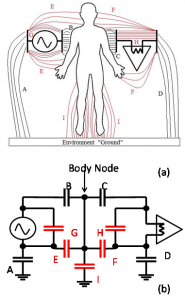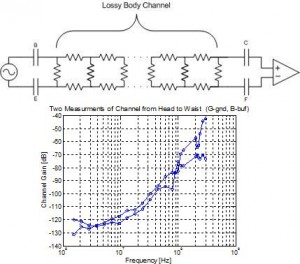Wireless Body Area Networks Using Body-coupled Communication
- Category: Circuits & Systems, Medical Electronics
- Tags: charles sodini, grant anderson
To achieve comfortable form factors for wireless medical devices, battery size, and thus power consumption, must be curtailed. Often the largest power consumption for wireless medical devices is in storing or transmitting acquired data. Body area networks (BAN) can alleviate power budgets by using low power transmitters to send data “locally” around the body to receivers that are around areas of the body that allow for larger form factors, like the wrist or the waist. These receivers, which have larger power budgets, can then process and store the data or send it elsewhere using higher power transmitters.
Body-coupled communication (BCC) shows great potential in forming a BAN. Traditional two-node BCC works by forming two capacitive links between a transmitter and a receiver, creating a circuit loop. One of these links is created by both the transmitter and receiver capacitively coupling to the body, effectively using the body as a low-resistance channel between the respective capacitors. The second link is created by coupling both the transmitter and receiver coupling to the environment, or “earth ground,” and using it as a return path. Larger BANs can be made by coupling additional nodes to both the body and the environment.
An application for a BAN is for an implanted EEG recorder at the head, to communicate with a base station at the waist. For implants, the traditional BCC will not work because capacitors E and F will short out capacitors A and D, reducing the transmission line between the transmitter and receiver to that shown in Figure 2. FSK data was sent across this channel in a variety of environments and activities including talking outdoors on a cell phone, exercising at a gym, and doing household chores. There was no significant difference in the BER across these different environments.
- Figure 1: (a) The electric field lines made between the transmitter, receiver, body, and environment. (b) The circuit diagram for (a); the red capacitors are parasitic and degrade functionality.
- Figure 2: The model for using BCC with implants. The body node is no longer modeled as a conductor but as a lossy transmission line. Below is the gain of this channel from head to waist
- T. G. Zimmerman, “Personal area networks (PAN): Near-field intrabody communication,” Master’s thesis, Massachusetts Institute of Technology, Cambridge, 1995.
- S.-J. Song, N. Cho, S. Kim et al., “A 0.9V 2.6mW body-coupled scalable PHY transceiver for body sensor applications,” ISSCC Dig. Tech. Papers, pp. 366-367, Feb. 2007.
- A. Fazzi et al., “A 2.75mW wideband correlation-based transceiver for body-coupled communication,” ISSCC Dig. Tech. Papers, pp. 204-205, Feb. 2009.

